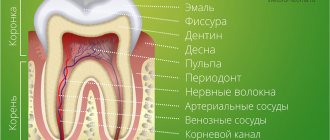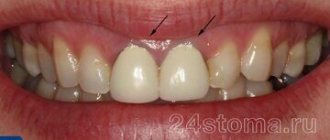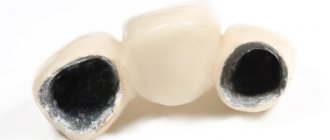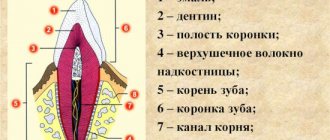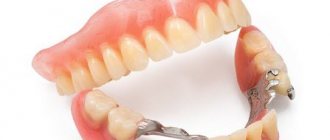Signs that make it easy to determine a person’s character by their teeth
Shape of teeth
says a lot about a person, and you can determine
the type of person by his teeth
by paying attention to the following signs of the dentition:
Upper incisors
| People with long incisors They are usually the life of the party, but at the same time they persistently strive for their goals and are quite open in communicating with others. Large incisors most often occur in adamant, stubborn people who persistently pursue their goal. Despite their difficult nature, those with large teeth are distinguished by their sincerity. Large gap between teeth betrays the explosive nature of their owner. In addition, the hole indicates an addiction to risk, which is not always justified. |
Fangs
It is generally accepted that large, sharp teeth
, including fangs, speak of a person’s aggressiveness. In fact, this is not always the case. In most cases, such teeth reveal a loving person. They can also talk about determination.
For example, if a woman’s upper canines are large and long
, then this can emphasize her kindness and humor.
Evenness of teeth
| A person's character can be determined by the curvature or straightness of their teeth. Ideal dentition speaks of a balanced, calm character. Such people are not afraid to make decisions and take responsibility. They are eloquent, self-confident and ready to go towards their goal no matter what. Uneven teeth speaks of the good intuition of the owner of the teeth. |
A person’s small, fox-like teeth can also tell about a person’s character.
— owners of such dentition are often characterized by lust.
Protruding teeth
characteristic of stingy people.
Teeth size
Strong large teeth
testify to a person’s courage, strength and kindness. Such people are most often long-livers.
| They will tell you what character the girl has and small teeth - often their owners are quite secretive and reserved natures. They have a small number of friends. Often people around them simply do not understand them, considering them strange. What do sparse teeth a person does not need to think for long - such teeth indicate people with a wild imagination, who always have a fresh, interesting idea in their heads: they can often even be considered strange. They are also distinguished by their tenacity of character and always go towards their goal. |
Small teeth
, among other things, can talk about greed. Such people have a hard time parting with money and are certainly not ready to spend it on others, be it relatives or friends.
Presence of damage
The presence of damage to the dentition can also indicate the character of a person
So, if
the upper row of teeth is damaged
, this will indicate difficulties in unlocking your potential, and if there are
problems in the lower part (especially in the left)
, you should think about problems in family relationships.
Our character and destiny are in our... teeth!
The concept means “the ability to judge a person’s internal qualities by appearance, and especially by face, and make a conclusion about his character.”
According to this teaching, the shape, size and location of teeth, along with other external features of a person, play an important role in the spiritual characteristics of a person. For example, those with straight teeth are, as a rule, wise and eloquent people, while significant gaps between the teeth indicate a weak-willed person. Cunning (and always fussing) people most often have small and sparse teeth. If the teeth protrude strongly forward, most likely the person is stingy, and those with long teeth are often evil and greedy. The gap between the front teeth - what is called a diastema in dentistry - in physiognomy speaks of frivolity and a cheerful disposition. Large teeth are found in brave and kind people, and different heights of the teeth indicate the thoughtfulness of their owner. Determined and energetic people most often have sharp and strong teeth.
Since ancient times, different peoples have had proverbs emphasizing the relationship between a person’s teeth and his character and destiny. In Rus', it was believed that teeth that were far apart from each other foreshadowed a happy life. In England it was also believed that “a child with few teeth will grow up happy and inclined to travel.” In the English city of Northampton they always said that those with a large gap between the upper incisors would become rich people. And in northeastern Scotland, the same sign indicated a person’s carelessness and excessive passion for the opposite sex.
In China, for a long time, they believed that teeth speak about a person’s relationships with other people and in the family, about the stability of life and the ability to enjoy delicious food. And in all these respects, long, straight, flat and white teeth are the best option. Only owners of such teeth can count on happiness in life and good relationships with people. White or ivory teeth will bring a person a good position in society and a high position, while yellow, dark, small and sparse teeth indicate a short and troubled life, poor relationships with people and an unstable financial situation.
In China, a person’s teeth are associated not only with his character, but also with his destiny. For example, it is believed that a person with protruding teeth will have to achieve everything in life on his own and not count on anyone. Success for such people comes far from their home. The owner of long (“dog”) front teeth most often becomes a tragedy for his family. Wealth, fame and a long life await a person who has large, white, dense teeth, also called “horse teeth.” A good marriage and an abundance of food are predicted for people with “garnet” teeth, that is, people whose middle teeth are larger than the rest, and the upper ones are, as it were, rounded downwards. Rare teeth indicate money problems and incontinence in conversations, inability to keep secrets, since, according to Chinese teaching, both wealth and information leak through such teeth. But special caution is recommended for those with “devil’s teeth” - crooked and zigzag teeth. Such teeth speak of a person’s envy and vindictiveness, his dishonesty in the areas of love, friendship and finance.
It is also interesting that in China much attention is paid to the number of teeth and it is believed that the more teeth a person has, the more happiness he will have in his life. Success in life awaits only a person who has more than 30 teeth, otherwise poverty and bad luck will befall him. The symmetry of the teeth is considered separately: teeth that are wide at the top and narrowed at the bottom speak of a person’s greed and cruelty.
It should be noted that the greatest attention in physiognomy is paid to the two front teeth. It is by them that one should determine whether a person is worth trusting. They also talk about how long and stable his life will be. If the front teeth are wide, straight and without gaps, and the remaining teeth are different from them, then this most often indicates that there will be no great success in a person’s life, but no great misfortunes will happen either.
Materials provided by Dentalworld portal
.
Raisins are worse for teeth than chocolate
Not all sweets are equally harmful to teeth. Sugar from various foods is a breeding ground for bacteria, which create acid that destroys teeth. Foods that get stuck in teeth, including bread, chips, and dried fruits, are often more harmful than those that dissolve quickly (chocolate, chewing candies). At the same time, it is better to eat sweets right away than to have many snacks throughout the day, constantly feeding bacteria.
In the future we will not have wisdom teeth
Third molars, or wisdom teeth, helped our larger-jawed ancestors grind roots, nuts, and leaves. But now about 35 percent of people are born without wisdom teeth. For the rest, dentists recommend removing them, since our oral cavity is too small for them. When our body no longer needs certain organs or parts, they become vestigial and eventually disappear. According to scientists, future generations will not have an appendix, wisdom teeth and perhaps even little toes.
The structure of the fangs
The canines of the upper jaw are shaped like an irregular cone. The cutting edge is shaped like a triangle, which is limited by three teeth - a pronounced middle one and two outer ones. The area of the tooth facing the lip (vestibular) has a convex shape and gradually approaches the lingual.
On the lingual part of the tooth there is a longitudinal ridge that divides the dental crown into two facets: the lateral part has the largest area. The upper canine has a pronounced crown curvature and root deviation.
The root of the tooth is quite thick and has a shape slightly compressed from the sides. Wider in anteroposterior dimension. The lateral and medial surfaces are very wide and have barely noticeable grooves.
The tooth has one, wide enough and accessible if treatment is necessary, root canal.
The canines located on the lower jaw are smaller in size than the upper ones, and the shape of the crown is close to the upper lateral (side) incisors. They are slightly narrower and longer than the upper canines. The medial surface is in a straight line with the root line. The cutting edge is less pronounced. The distal part of the cutting edge is longer than the medial one.
The labial surface of the lower canines is less convex and pronounced than that of the upper ones, and the lingual surface can be either straight or slightly concave.
The lower fangs have a slightly shorter tooth root than the upper ones, but they have absolutely no differences in shape. In rare cases, anatomical pathology occurs in which the root is divided into two parts.
The canines of both jaws have quite pronounced external differences in the dental crown, but at the same time the dental cavities are very similar.
What could be the consequences?
The problem most often manifests itself exclusively from an aesthetic point of view - psychological problems arise, the patient wants to correct the pathology as quickly as possible, especially if it is pronounced. That is, if the teeth and gums are healthy, then such discomfort is the only consequence of the problem.
If the short size of the crowns is caused by an abnormal structure of the teeth, problems with the gums, or abrasion of the enamel, then the consequence of this condition may be inadequate chewing of food, which will inevitably lead to problems with the gastrointestinal tract, premature aging of the face and the appearance of deep wrinkles near the mouth, and general deterioration dental conditions and even their loss.
Evolution of tooth size
Our distant ancestors, who lived about 100,000 years ago, had very large teeth - about twice as large as those of modern humans. This was a vital necessity. With the help of teeth it was necessary to gnaw animal bones and tear raw meat. But with the development of the brain and changes in diet, they gradually decreased. Scientists have calculated that every thousand years, 1% of their surface “gone” (although it is possible that over the past centuries this process has accelerated significantly).
The changes affected not only the overall size of the teeth, but also their purpose. The largest tooth in modern humans is the first upper molar: in the process of evolution, the main functional role has passed to it from the second upper molar. The fangs, which were no longer so important for holding food, were transformed the most.
How to fix small teeth?
Small tooth: what to do if it causes inconvenience, reduces self-esteem and worsens quality of life? Depending on the severity of the picture, the dentist may suggest the following correction methods:
- In case of isolated microdentia, small teeth can be corrected by installing veneers or lumineers - thin plates that are attached to the front surface of the tooth. This method is also suitable for eliminating threes and diastemas and increasing the width of the visible part of the crown. If your teeth grow unevenly, you will most likely need orthodontic correction using braces before placing veneers.
Reasons why teeth become small
As a rule, most of the reasons leading to the appearance of small front teeth in adults come from childhood, when pathological processes interfere with the formation of body systems. Microdentia can be a consequence of:
- severe infections suffered before the age of 2 years;
- exposure to radiation;
- inflammatory diseases in the mother during pregnancy;
- early removal of baby teeth;
- underdevelopment of the alveolar ridge and, as a consequence, lack of sufficient support for “growing” teeth of normal size.
Treatment and prevention of dental anomalies
It should be remembered that dental anomalies are a serious disease for patients of all ages and professions and require long-term and thorough therapy to maximize or completely eliminate dental pathologies. Modern dentistry and advanced equipment are capable (if not completely, then maximally) of eliminating the manifestations of dental anomalies. A timely visit to a specialist in order to establish an accurate diagnosis and determine a treatment plan can guarantee a favorable prognosis for recovery. Dentists will be able not only to restore the functional abilities of the jaw, but also to eliminate various aesthetic defects.
Prevention of the formation of dental anomalies begins with taking care of the correct intrauterine and postnatal development of the child. This includes:
- balanced diet;
- timely correction of endocrine disorders;
- regular visits to the dentist to carry out the necessary preventive and therapeutic measures;
It is important to monitor your own health in the first days after the birth of your child.
Early breastfeeding and a balanced diet will help avoid many dental anomalies. We should not forget about a complete preventive examination by the dentist - at least once every six months. Moscow metro station Zvezdnaya, Danube Avenue, 23
Diagnosis of microdentia
According to statistics, about 5% of people face the problem of microdentia – abnormally small teeth in an adult. There are several signs that allow you to distinguish microdentia from other dental pathologies.
Symptoms of microdentia
- teeth of regular shape, but with a significantly reduced crown;
- distances between teeth visible to the naked eye;
- damage mainly to the front teeth;
- wavy or jagged shape of the cutting part of the affected tooth.
In most cases, the presence of microdentia can be determined by visual examination of the patient, but for a more accurate diagnosis, hardware diagnostics are performed. For example, the doctor can measure the overall width of the incisors of both jaws using a special instrument, as well as resort to x-rays. A deviation is considered to be a reduction of teeth by 1.5 mm or more relative to the norm. Based on the results of the examination, one of three types of microdentia is determined.
Isolated
If the patient has one or two small teeth, then we are talking about isolated microdentia. Most often, the front incisors (mainly the lateral incisors) are underdeveloped.
Relative
Relative microdentia is said to occur when the patient has an abnormally enlarged jaw. On such a jaw, even normal-sized crowns can look disproportionately small. Thus, relative microdentia is an overly large gum and small teeth on it.
Generalized
In the most severe cases, when small teeth are located throughout the jaw, the patient is diagnosed with “generalized microdentia.”
Some people have too many teeth
About 2 percent of people experience hyperdontia, in which a person grows additional supernumerary teeth. Many of these teeth remain hidden under the gums, but sometimes they erupt and begin to crowd out other teeth. It is very rare for a person to lose a permanent set of teeth at an older age and grow another set. Everyone else will need dentures.
